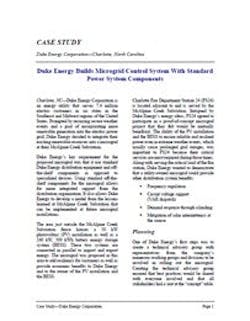Duke Energy Corporation is an energy utility that serves 7.4 million electric customers in six states in the Southeast and Midwest regions of the United States. Prompted by recurring severe weather events and a goal of incorporating more renewable generation into the electric power grid, Duke Energy decided to integrate their existing renewable resources into a microgrid control system at their McAlpine Creek Substation.
Duke’s key requirement for the proposed microgrid was that it use standard Duke Energy distribution equipment and off-the-shelf components as opposed to specialized devices. Using standard off-the-shelf components for the microgrid allows for more integrated support from the distribution organization. It also allows Duke Energy to develop a model from the lessons learned at McAlpine Creek Substation that can be implemented at future microgrid installations.
Duke wanted to demonstrate that a utility-owned microgrid could provide other distribution system benefits:
- Frequency regulation
- Circuit voltage support (VAR dispatch)
- Demand response through islanding
- Mitigation of solar intermittency at the source
One of Duke Energy’s first steps was to create a technical advisory group with representatives from the company’s numerous working groups and divisions to be involved in rolling out the microgrid. Creating the technical advisory group ensured that best practices would be shared with everyone involved and that all stakeholders had a seat at the “concept” table.
